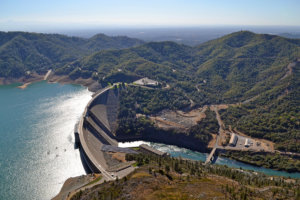Invest in watershed improvements, not taller dams
 by Laurie Wayburn
by Laurie Wayburn
There is broad consensus that California’s water challenges are only going to get worse as climate change continues. We will have more drought, more major rain events with consequent flooding and more uncertainty. In this era of global warming, we need new approaches to help solve our water problems.
The Trump administration proposal to raise the Shasta Dam by 18½ feet, along with the recent vote by the Metropolitan Water District of Southern California to support the delta tunnels, illustrate our complete and outmoded dependence on built infrastructure to provide water. Both ignore the least expensive and most effective means of increasing water security: restoring the watersheds that supply the vast majority of utilized water in the state.
Much of the state’s consumed water comes from three reservoirs that feed into the Sacramento River: the Shasta, Trinity and Oroville. The spillway collapse at Oroville dam last year was a wake-up call that California must address its water infrastructure, both built and natural. While the dam was structurally unsound, had the forests and meadows in its watershed been healthy and functioning they would have been able to absorb and store more of those torrential rains. By releasing water more slowly, over weeks rather than hours, this natural infrastructure would have helped reduce the intense pressure on the weakened dam for which initial costs from repairs already exceed $800 million. The next phase of work is estimated to climb into the billions of dollars.
The Shasta Dam, on the other hand, is not ailing and has topped out only a handful of times since it was built — 2017 was the first time in two decades. Raising it would not address any broad public benefit but would only, on an occasional basis, help out powerful water interests in the San Joaquin Valley, primarily Westlands Water District. A smarter investment of taxpayer money would be to address the serious problems in the watershed itself, where restoration and conservation would both increase storage and provide more reliable flows in both drought and intense rain events.
The Oroville and the Shasta reservoirs rely on their surrounding watersheds — nearby forests, meadows and streams — to deliver clean, abundant water that is then stored and funneled south. These source watersheds are natural storage facilities that collect, hold, treat and transport drinking water to more than 28 million people and provide millions of acres of irrigation as well as 85 percent of the freshwater to San Francisco Bay. They are essential to the entire state’s water supply, and they are in trouble.
We know watershed restoration and conservation can significantly increase water quality, quantity and storage, as well as improve flow regulation, reducing peak flooding and holding water later into the summer season when we need it most. A number of practical strategies have been identified as key to restoring watersheds, including forest fuels reduction, reintroduction of prescribed fire, wet and dry meadow restoration preventing further fragmentation, and road repair. A watershed-wide effort will yield substantial water and other public benefits, including supporting thousands of jobs in Northern California rural areas. It would also help with a fair cost share of the expenses in maintaining and repairing this natural infrastructure, the same way we do with dams. Currently, only taxpayers and private landowners pay for these watershed functions, at about $250 million a year; it’s only fair that other water beneficiaries pay toward this as well.
Watershed conservation is one of the least expensive solutions to ensure greater water quantity, quality and security, cheaper than building new infrastructure and certainly more cost effective than the initially estimated $1.3 billion price tag to raise Shasta Dam. Unlike large dam infrastructure projects, which consistently have cost and time overruns, natural infrastructure projects have been accomplished under budget and on time. New York City, for example, used watershed conservation policies in the 1990s to clean city water more cheaply than by building a new water treatment plant.
It makes far more sense to invest in the security and climate resilience of our water at its source than to pour money into raising Shasta dam, a Trump administration proposal that has rallied strong opposition from state leaders. Restoring our natural water infrastructure will provide cleaner, cooler water for all Californians and improve reliability year after year.
It’s time to establish a system enabling comprehensive investment in our natural water infrastructure that protects California’s water for the future. If we’re going to spend taxpayer money on securing our water supply, let’s make sure it benefits everyone.
Laurie Wayburn is President of Pacific Forest Trust. This Op Ed originally appeared on the San Francisco Chronicle website on May 4, 2018 and in print on May 7, 2018.

